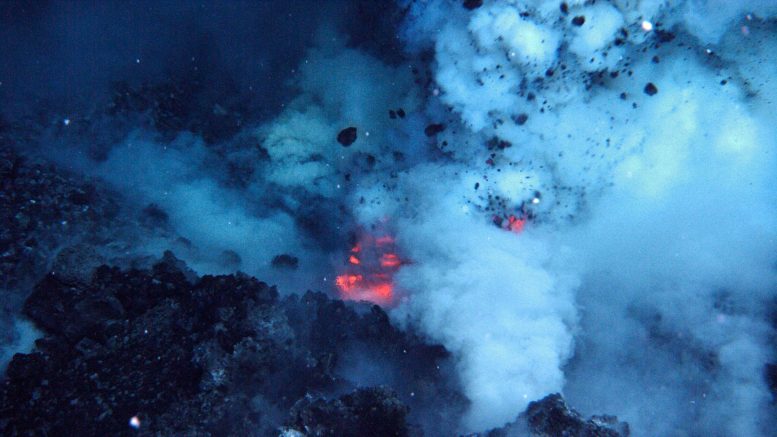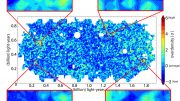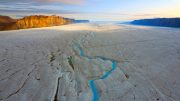
West Mato Volcano erupting in 2009. Credit: Image courtesy of the National Oceanic and Atmospheric Administration
Volcanic eruptions deep in our oceans are capable of extremely powerful releases of energy, at a rate high enough to power the whole of the United States, according to research published today.
Eruptions from deep-sea volcanoes were long-thought to be relatively uninteresting compared with those on land. While terrestrial volcanoes often produce spectacular eruptions, dispersing volcanic ash into the environment, it was thought that deep marine eruptions only produced slow moving lava flows.
But data gathered by remotely operated vehicles deep in the North East Pacific and analyzed by scientists at the University of Leeds, has revealed a link between the way ash is dispersed during submarine eruptions and the creation of large and powerful columns of heated water rising from the ocean floor, known as megaplumes.
These megaplumes contain hot chemical-rich water and act in the same way as the atmospheric plumes seen from land-based volcanoes, spreading first upwards and then outwards, carrying volcanic ash with them. The size of megaplumes is immense, with the volumes of water equivalent to forty million Olympic-sized swimming pools. They have been detected above various submarine volcanoes but their origin has remained unknown. The results of this new research show that they form rapidly during the eruption of lava.
The research was carried out by Sam Pegler, from the School of Mathematics and David Ferguson, from the School of Earth and Environment and is being published today (April 21, 2021) in the journal Nature Communications.
Together they developed a mathematical model which shows how ash from these submarine eruptions spreads several kilometers from the volcano. They used the ash pattern deposited by a historic submarine eruption to reconstruct its dynamics. This showed that the rate of energy released and required to carry ash to the observed distances is extremely high — equivalent to the power used by the whole of the USA.
David Ferguson said: “The majority of Earth’s volcanic activity occurs underwater, mostly at depths of several kilometers in the deep ocean but, in contrast to terrestrial volcanoes, even detecting that an eruption has occurred on the seafloor is extremely challenging. Consequently, there remains much for scientists to learn about submarine volcanism and its effects on the marine environment.”
The research shows that submarine eruptions cause megaplumes to form but the release of energy is so rapid that it cannot be supplied from the erupted molten lava alone. Instead, the research concludes that submarine volcanic eruptions lead to the rapid emptying of reservoirs of hot fluids within the earth’s crust. As the magma forces its way upwards towards the seafloor, it drives this hot fluid with it.
Sam Pegler added: “Our work provides evidence that megaplumes are directly linked to the eruption of lava and are responsible for transporting volcanic ash in the deep ocean. It also shows that plumes must have formed in a matter of hours, creating an immense rate of energy release.
David Ferguson adds: “Observing a submarine eruption in person remains extremely difficult but the development of instruments based on the seafloor means data can be streamed live as the activity occurs.
Efforts like these, in concert with continued mapping and sampling of the ocean floor means the volcanic character of our oceans is slowly being revealed.”
Reference: “Rapid heat discharge during deep-sea eruptions generates megaplumes and disperses tephra” by Samuel S. Pegler and David J. Ferguson, 21 April 2021, Nature Communications.
DOI: 10.1038/s41467-021-22439-y









The paper does not mention the effect of undersea volcanism on the atmosphere and climate. It has been estimated that there are 3.5 million undersea volcanoes; a proportion of these erupting at any one time injects heat into the ocean that eventually warms the atmosphere giving rise to ENSO (see Prof. Wyss Yim) and obviously affecting the global air temperature. Would be interested in your comments.
I wonder how many ppl think about the warming issues mitigated by undersea volcanoes. It’s the real deal.
And how precisely would one extract the energy to make it available to the US economy, show us some design proposals. It always comes back to energy density.
I have had an interest in tectonic plate technology for many years. I was an electronics engineer by profession but have always had an interest in geology dating vack to the days of my education when plate tectonics was a very new to science fact.
In reading this article my thoughts turned to the warming and subsequent ice melting of the Arctic Ocean. I have read a few papers describing this and the explanation that because of the depth of the ocean the volcanic eruptions from the fault lines on the sea bed of this ocean could not cause enough heating to melt the ice and thus it has been put down to climate change.
However, reading this article and the consequential effects of the type of eruptions described makes me wonder again whether the number of active tectonic plate faults within the Arctic Ocean which is essentially an enclosed body of water due to the surrounding land masses is in fact an as yet un-reasearched cause of the accelerating ice melt.
It would be an amazing research project to undertake.
I’m interested in the way the minerals disperse and the means in which we have as a species to extract it. Then how it’ll effect the underwater environment when we choose to do so. It’s best to obtain energy without disrupting the balance of nature.
I’m interested in the way the minerals disperse and the means in which we have as a species to extract it. Then how it’ll effect the underwater environment when we choose to do so.
I have read that an estamated 70% of volcanic activity is in deep oceans, but this seems to be a simple assumption from the fact that 70% of the globe is covered by oceans . . . since the crust is hundred or thousands of feet, up to 5 or 6 miles, thinner undersea than on land, it follows that there may be much more subsea volcanism than we know, or think, but, very hard to detect unless you happen to have a submersible in the right place at the right time . . . what if 5% of volcanism is on land, and 95% of volcanism is subsea?
Water is about 1,000 times heavier than air at sea level, so it takes a gallon of air at 1,060 degrees to warm a gallon of water at 60 degrees 1 degree, so a warming climate (air) is a very inefficient warmer of the the seas, but warming seas (heated by volcanism) are a very efficient warmer of the air, the atmosphere, the climate.
Thus I think the effect of subsea volcanism and geothermal heating may be extremely under estimated.